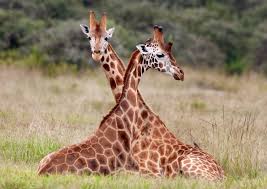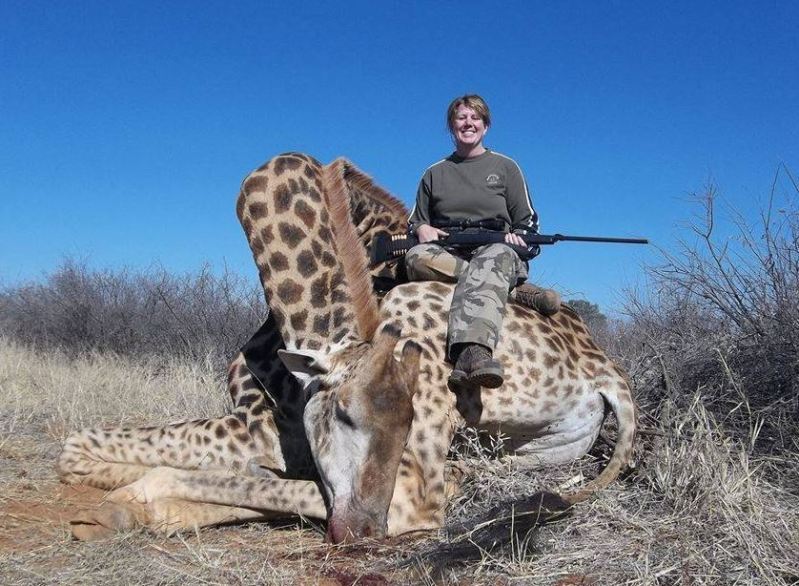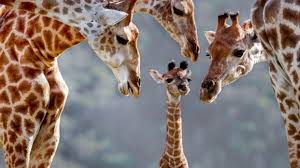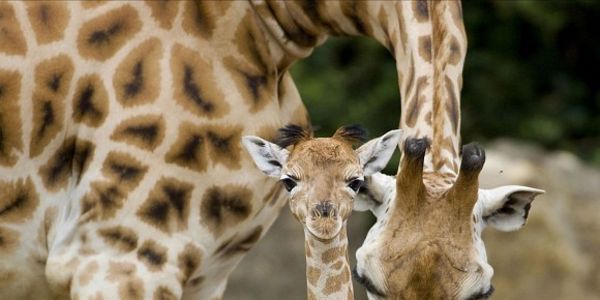
THE WORLD’S TALLEST LAND MAMMAL IS ENDANGERED

“Evolution is so creative. That’s how we got giraffes.”
– Kurt Vonnegut
They are so gracious animals, elegant and majestic but also very cute. We can look at them and smile with no reason. The world’s tallest land mammals have never done something wrong to people but people have done so much wrong to the giraffes in last 30 years. We have made them vulnerable to extinction and today, on Wednesday, June 21, on World Giraffe Day, we are aware more than ever that conservation must do something urgent regarding this issue.

We are running out the time because they are already placed on the Red List of endangered species. There are fewer than 100,000 left in wild and their number is dropping down rapidly due to the loss of habitat and illegal, so called trophy hunting. International Union for the Conservation of Nature (IUCN) warns that the statistic is black not only for giraffes which population has been reduced up to 40% but also for other species that are also declared as endangered. It seems that environmental problem is getting bigger and bigger and that there is no common agreement among countries how the global extinction crisis will be sorted out.

According to the latest reports from IUCN, the burning case of giraffe’s extinction has come out as the product of human unlimited and aggressive colonization of natural habitats and wilderness:“Giraffes were once widespread across southern and eastern Africa with smaller sub-populations in west and central Africa.Numbers have declined from around 151,702 to 163,452 animals in 1985 to 97,562 individuals in 2015, the IUCN said, with a growing human population having a negative impact.” Those mammals are human-friendly oriented and they do not bother the people but they are bothered by people who want the areas that do not belong to them. Beside that, the advanced level of trophy hunting has had influence on giraffe’s life too. Just in recent years, on many social media, there were hundred of photos of sadistic trophy hunters that have posed by the killed giraffes. Someone would ask:Why hunters kill the totally harmless and innocent animals like giraffes? They are not hunters that kill for food, they are monstrous killers that kill for their own, sick pleasures and collect the souvenirs like the most famous serial killers, described in FBI expert analyses.

What we need to keep in mind when we talk about the giraffe’s population is the fact that there are nine subspecies and based on BBC wildlife report:“Of these, five have had falling populations, one has remained stable while three have grown. Different outcomes seem to be highly dependent on location.” The giraffe’s destiny is written depending on the certain geographic position. In the zones that are targeted with armed gangs and civil wars, the giraffes are paying the high price as the big animals that can feed the whole village. The species that are located in southern Africa have more peaceful life than those that live in in northern Kenya, Somalia, and Ethiopia in the border area with South Sudan. The mankind’s madness and political instability define the conservation policy and the chances for its recovery.

Personally, I believe that something could be done and that could bring positive results. The hope is still there because the giraffes are beloved animals and they do not cause the damage to the people colonies. The only question is how it will be make the balance between human needs and the needs of the mentioned mammal? The both try to find their own place and to survive but humans have taken all for granted. In spite of rare animals dropped population, the people are producing themselves almost like microbes, especially in rural areas that are known for low level of reproductive culture. They cause the bigger pressure on the Earth’s resources and make a base for a big sixth mass extinction.

The sustainable development must be set up as well as the reasonable conservation policy. In the areas where the human population is booming, the local staff should start education process and sharing the knowledge about the negative side of the unlimited number of people. That will target not only the animals and their habitat but also the life of the other people and their already minimal chances for normal existence. Everything is so connected and the reducing of animals because of the loss of their natural environments, lead us to the chain of the new emerging infectious diseases. As long as we keep pushing our primitive needs onto the nature, we will end up dying from dangerous like-Ebola viruses.
The working project on protecting the giraffes has been started successfully in South Africa and could be used as a good example for other lands to do the same.Chris Ransom from the Zoological Society of London is sure that giraffes have the safe future if the rational conservation steps are following the recommendations of scientists :”The success in keeping giraffe numbers high in Southern Africa has much to do with the management of game parks for tourists say experts, who believe that the extra attention that the IUCN listing will now attract will benefit the species.South Africa is a good example of how you can manage wildlife, there is a lot of moving of animals between different conservation areas, it is a very different scenario than in most of the rest of Africa.I think giraffes can survive, with the right conservation efforts, and we can ensure that the animals do live in the wild. There are a lot of cases of success in conservation. The giraffes could be one.”

As I have always mentioned in many of y wildlife related articles, the nature and the human habitat must keep distance for a mutual benefit. What does it mean? The respect for space and species. If we think that we will manage to grab this Planet only for ourselves, we will definitely experience our own extinction because the Earth must be shared among all creatures that are supposed to be here. The human race is not and should not pretend it is the dominant because that dominance could only apply on our ignorance.

The giraffes deserve their own free areas and people that will not poach them and kill for fun and posing photos as a confirmation of sadistic personality. The giraffes should be protected not only from the trophy hunters and illegal killers but also from the mankind’s appetite for wildlife destruction.
https://giraffeconservation.org/

Sarah’s evocative and invaluable article reminded me of the film ‘The Gods Must Be Crazy’ (1980); concerning the nomadic San people of Southern Africa and their perception of the modern world. The San were among the earliest Homo sapiens to record their prehistoric interactions with giraffes (i.e. via rock paintings). They revered the giraffe and continued to do so for millennia… The San people have medicine dances named after some animals: The Giraffe Dance is performed to treat head ailments, ostensibly.
In prehistoric periods, giraffes were common targets for hunters, throughout Africa: the San did hunt them, but had a profound deference for them; as the San were Animists. Different parts of their bodies were used for different purposes. Their meat was used for food. The tail hairs served as flyswatters, bracelets, necklaces and thread. Shields, sandals and drums were made using the skin, and the strings of musical instruments were from the tendons. The smoke from burning giraffe skins was used by the medicine men of Buganda to treat nose bleeds. The Humr people of The Sudan consume the drink Umm Nyolokh; which is created from the liver and marrow of giraffes. Umm Nyolokh contains N,N-Dimethyltryptamine (DMT) and other psychoactive substances from plants the giraffes eat (e.g. Acacia), and is known to cause hallucinations of giraffes (believed to be the giraffes’ ghosts by the Humr).
In the 19th century, European explorers began to hunt giraffes for sport. Habitat destruction has hindered the giraffe, significantly: in The Sahel, the need for firewood and grazing room for livestock has led to deforestation. Normally, giraffes can coexist with livestock; since they do not directly compete with them. The San lived in harmony with the giraffes. The San were semi-nomadic people; moving seasonally within certain defined areas based on the availability of resources (e.g. fresh water, animals and edible plants). From the 1950s through the 1990s, the San switched to farming, because of government-mandated modernisation programmes, in Botswana.
Despite some positive aspects of government development programmes reported by members of the San, many have spoken of a consistent sense of exclusion from government decision-making processes, and many San have alleged experiencing ethnic discrimination on the part of the government. In turn, this has affected their ability to live in harmony with the giraffes.
Traditionally, the San were an egalitarian society. Though they had hereditary chiefs, their authority was limited. The San made decisions among themselves by consensus; with women treated as relative equals. The San economy was a gift economy, based upon giving each other gifts regularly, rather than on trading or purchasing goods and services.
Arguably, had the San influenced other humans into revering such creatures as the giraffe, this majestic and unique animal would not be listed as Vulnerable by The International Union for Conservation of Nature (IUCN).
Sarah concludes her imperative article with a plea to the general public to endeavour to protect giraffes from the worst aspects of humans. We are all custodians and guardians of Nature…
LikeLiked by 1 person
This article has added so much to my knowledge about Giraffes ! What a well-documented and well-organized article, Sarah !
It has saddened me so much to see the pictures of the Giraffes killed by those so-called trophy hunters. To me, they are just losers who are destroying our natural treasures/Animals ! Those are the same “people” who don’t even understand the meaning of Ecosystems and/or the meaning of Environment ! And it’s their ignorance, if it continues to go unchecked, that will bring about cataclysmic imbalances to our existing Ecosystems and our Environment !
The South African model has to be replicated throughout Africa in order to preserve those poor, innocent, defenseless, and beautiful Giraffes !
As you said, Sarah, in so many of your articles, ‘humans” have to stop imposing this horrendous pressure/demand on our planet, as our planet cannot sustain such demand for much longer ! the time to act is now before it’s too late not only for our beloved animals, but also for the”human” race itself !
Thank you so much, Sarah, for providing this critical information in such a succinct manner, which allows us to absorb so much in so little time !
LikeLiked by 1 person
Thank you, dear Sarah, as always, an excellent article. It is so sad, but true that we are saying goodbye to many creatures that are in danger of distinction. Your article includes a brainless person posing on top of a killed Giraffe. Sick is her heart, and God adds her malady. On the contrary, your article includes a mindful person taking care of a Giraffe. It really takes a great person to be kind and caring. Unless we as individuals, communities, and governments all around the world work together to save, protect, and free such creatures, we will ourselves witness their distinction. Again, thank you dear Sarah for being an animal lover and nature advocate.
LikeLike
I read a few very good stuff here. Definitely
worth bookmarking for revisiting. I’m wondering how much effort you put to
produce such a great informative website.
LikeLike
Do not touch animals!
LikeLike
Like!! Really appreciate you sharing this blog post.Really thank you! Keep writing.
LikeLike
This site truly has all the information and facts I needed concerning this subject and didn’t know who to ask.
LikeLike